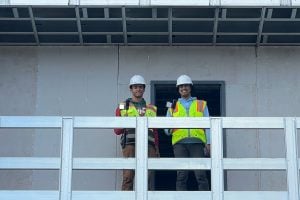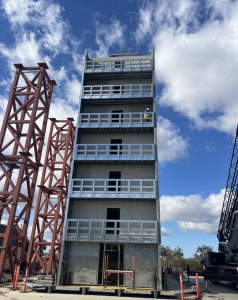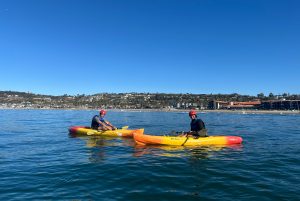
Two Johns Hopkins engineering students spent part of their winter intersession helping to build a 10-story cold-formed steel (CFS) structure in San Diego that will test how midrise buildings can withstand earthquakes. The project, primarily funded by the National Science Foundation (NSF) Natural Hazards Engineering Research Infrastructure (NHERI), will serve as the capstone test for the Seismic Resiliency of Repetitively Framed Mid-Rise Cold-Formed Steel Buildings project.
Tayo Ilunga-Reed and Tyler Sugrim, both seniors in the Whiting School of Engineering’s Department of Civil and Systems Engineering, joined principal investigators Benjamin Schafer from Johns Hopkins and Tara Hutchinson from the University of California, San Diego (UCSD), on the project, which aims to better understand how cold-formed steel-framed building respond to damage from natural hazards.
 The building, currently still under construction at UCSD, is being built atop NHERI’s high performance outdoor shake table, which applies realistic earthquake motions to test structural systems. Construction is expected to be complete in late February 2025, with seismic testing scheduled for May 2025 and live fire testing scheduled for July 2025. Afterwards, the building will be evaluated for a full-scale damage response.
The building, currently still under construction at UCSD, is being built atop NHERI’s high performance outdoor shake table, which applies realistic earthquake motions to test structural systems. Construction is expected to be complete in late February 2025, with seismic testing scheduled for May 2025 and live fire testing scheduled for July 2025. Afterwards, the building will be evaluated for a full-scale damage response.
The project’s resulting data will be instrumental in refining how this unique structural system behaves even when utilized well past current building code limitations, and also used for loss and downtime estimates and in determining how quickly buildings can be restored to their intended function following natural disasters.
Once in San Diego, Ilunga-Reed and Sugrim spent two weeks assisting with tasks in preparation for the building’s test phase. They were responsible for installing a portion of the 800 strain gauges—devices to measure the building’s deformation—throughout the structure, applying fasteners to join the modular cold-formed steel (CFS) framing, painting foundation modules, logging inventory, and capturing 360-degree images for pre- and post-test analysis.
“I’ve always been interested in resilient design, particularly in developing hurricane-resistant homes,” said Sugrim. “Growing up in New York, I saw firsthand the devastation caused by Hurricane Sandy which left a lasting impact. I saw this project as a unique opportunity to contribute to research related to my interests and my future career as a structural engineer.”
“During our time on the project, we took on a role that was similar to that of construction managers. We worked closely with the general contractor, PhD students, faculty, postdocs, and even undergraduates from the other universities,” said Ilunga-Reed. “It was exciting to be onsite gaining hands-on professional experience, while also contributing to cutting-edge research.”
 Ilunga-Reed and Sugrim also made sure to take advantage of their free time, fitting in a day of kayaking in the Pacific Ocean and visiting Petco Park—a must-see for Sugrim, who’s also a member of Hopkins’ baseball team. Both students hope to return to work on the project following the seismic and live fire tests, scheduled for this spring and summer, to assist with the data analysis portion of the project. In the meantime, they are conducting small-scale tests related to details within the building in Schafer’s laboratory this spring.
Ilunga-Reed and Sugrim also made sure to take advantage of their free time, fitting in a day of kayaking in the Pacific Ocean and visiting Petco Park—a must-see for Sugrim, who’s also a member of Hopkins’ baseball team. Both students hope to return to work on the project following the seismic and live fire tests, scheduled for this spring and summer, to assist with the data analysis portion of the project. In the meantime, they are conducting small-scale tests related to details within the building in Schafer’s laboratory this spring.
The project is a collaborative effort that includes researchers from Cal Poly and the University of Massachusetts Amherst (UMass Amherst), with a companion effort focused on CFS-framed floor and roof diaphragms led by co-principal investigator Kara Peterman (Engr ’11, MS; ’14, PhD) from UMass Amherst.
The findings from the research are expected to significantly impact the future design and resilience of mid-rise structures in earthquake-prone regions.
After earning their bachelor’s degrees this spring, Ilunga-Reed and Sugrim will stay on to earn their master’s degrees at CaSE before entering the workforce. Sugrim plans to join a structural design firm, while Ilunga-Reed envisions a career in general contracting or construction management.